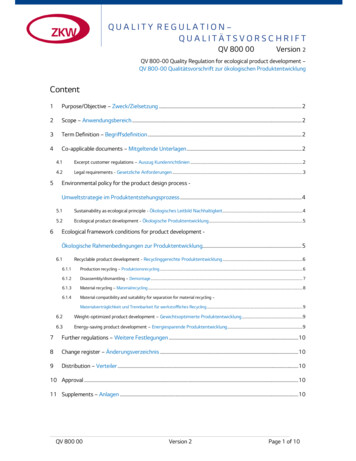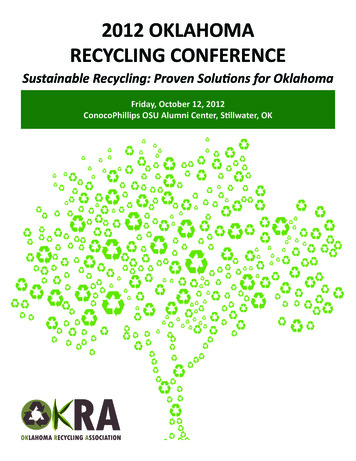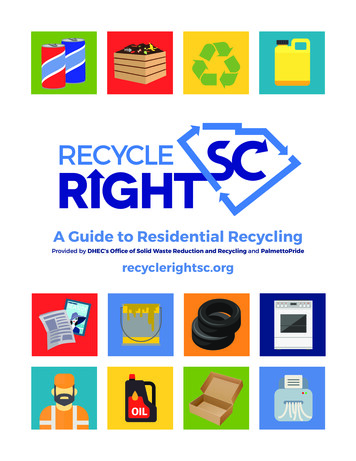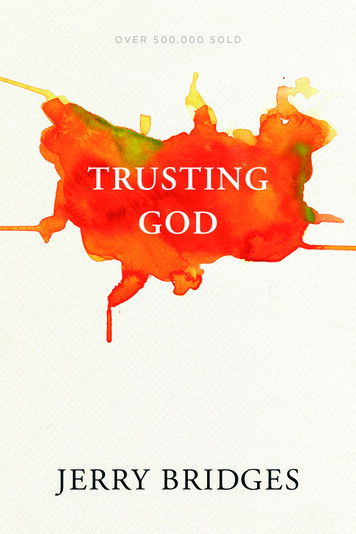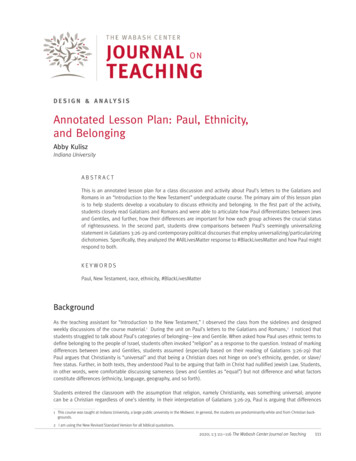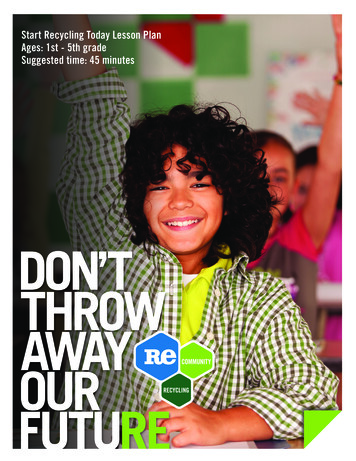
Transcription
Start Recycling Today Lesson PlanAges: 1st - 5th gradeSuggested time: 45 minutes
Introduction to RecyclingReCommunity Education Station Teacher Resources Lesson Plan 11Part 1- Introduction to RecyclingMost students today are already familiar with the concept of recycling. The purpose of this lesson is to: Educate students about the importance of recycling. Teach students which items can be recycled. Motivate students to recycle whenever possible, at school and at home.Section 1: How much trash is there?The average person in this country creates more than four pounds of trash daily. You can give students avisual by showing a bag of trash or passing a four-pound dumbbell around the room.Teaching Tip: To show how quickly this can add up, multiply four pounds by the number of students in class;and that number by seven to show how much trash the class produces in a week and then by 52 to illustratehow quickly this can add up.Explain that there is only so much room in landfills and many items sit for hundreds of years before“decomposing, or breaking down to become dirt”. And some materials, like Styrofoam and glass, neverbreak down and they take up space in landfills forever. In addition to taking up ground space, trash inlandfills pollutes the air we breathe. It has become necessary to keep trash out of landfills and in theproduct chain for years- that’s where recycling comes in.Section 2: What is recycling?To ”recycle” something means to use it again. Ask students what they know about recycling and why theythink it is so important.Questions to encourage classroom participation:“Does your family recycle at home?”“Do they separate the recycling or collect it in one bin?”“Do they take the recycling to a facility or put it on the curb with the rest of the trash?”“How do you help with recycling at home?”Explain that when recycling is picked up, it goes to a facility where the different materials are separated.The materials are then cleaned, broken down and turned into new products, Sometimes the material fromone item will be used to create an entirely different item. For instance, a water bottle can be recycled into anarticle of clothing or an area rug.More Recycling facts are available at:http://www.recommunity.com/education/
Introduction to RecyclingReCommunity Education Station Teacher Resources Lesson Plan 12Part 2 - VIDEOThe videos explain how products go from the bin, through the recycling process and back on storeshelves to be enjoyed again.Part 3 - In-class activitySection 1: Which Items Can Be Recycled?Test students’ knowledge by listing off various items and asking whether they can be recycled. To make thelesson more engaging, bring in each of the items you plan to list and place two bins in front of the class,one labeled “Recycling” and the other labeled “Trash”. Let students line up, pick an item and place it in thebin where they think it belongs. “Can you guess whether each of these items can be recycled or not?”YESNOGlass jarsPlastic Wrap, like Saran WrapPlastic water bottlesPlastic bagsCardboard boxesShredded paperNewspapersLight bulbNotebook and printer paperPlastic yogurt cupsSoda cansList of RecyclablesDirty DozenRECYCLE WELLTHE RECYCLING BIN’SDIRTY DOZENThese categories are acceptable for recycling.Study carefully and recycle well.Plastics 1-7(Jugs, Bottles,Bulky Rigids,etc)1Aluminum& Metal Cans2GlassBottles& JarsPaper(Office Paper, Junk Mail& Newspaper, etc)Cardboard &Food BoxesMagazines3456NO Plastic BagsPlastic bags are the WORST contaminant in the recycling bin. When placed in a curbsidebin, they get wet and dirty and cannot be recycled. Plastic bags with a #2 or #4 can berecycled at the CHaRM (Center for Hard-to-Recycle Materials ) if they are clean, dry and empty.They may also be recycled at participating grocery stores; find a list of participating stores.NO Materials in Plastic BagsWorkers have to slow the conveyor belts to rip open bags that contain recyclables andthen add the bag to the heap of bags bound for the landfill. These inefficiencies wastetime and money.NO Shredded PaperShredded paper is too small to sort. The pieces fall through the cracks of the sortingmachines, stick to the belts and end up all over the floor. Please avoid shredding whenpossible because it destroys the potential for recycling. Compost shredded materials in yourcurbside compost bin (if you have one) or recycle at your local Recycling Drop-off Center.NO Scrap MetalScrap metal items of any size should not go into your curbside bin. These items causeexcessive damage to the recycling equipment.NO Hazardous WasteHazardous waste such as paint, automotive fluids, car batteries and pesticides must betaken to your local Hazardous Waste Facility, not to the Recycling Center.NO Diapers or Bio-Hazardous WasteSyringes and needles, diapers and other sanitary products are not 05/re acceptable materialsuploads/2012/05/DirtyDozen.pdfresedential print.pdf
Introduction to RecyclingReCommunity Education Station Teacher Resources Lesson Plan 13Section 2: If you’re not sure, check the symbolExplain that in order to make recycling easier, all recyclable products feature a recycling symbol anda code that can usually be found at the bottom of the item. The recycling symbol means the productcan go around the usage chain many times. The code inside the logo tells us what type of material theproduct is made from and whether it can be recycled in your area. Print the recycling code chart belowto review with students.The Recycling SymbolPETEHDPEPVCPolythylene Terephalate EthylenePolypropylenePETE goes into soft drinks, juice, water,detergent, and cleaner bottles. Also usedfor cooking and peanut butter jars.PP goes into caps, disks, syrup bottles,yogurt tubs, drinking straws and film packaging.PPHigh Density PolyethylenePolystyreneHDPE goes into milk and water jugs, bleach bottes,detergent bottles, shampoo bottle, plastic bagsand grocery sacks, motor bottles, householdcleaners, and butter tubs.PS goes into meat trays, egg cartons, plates,cutlery, carry-out containers and clear tray.PSPolyvinyl ClorideOtherPVC goes into window cleaner, cooking oils,and derergent bottles. Also used for peanutbutter jars and water jugs.Other Includes resins not mentioned above orcombinations of plastics.OTHERLow Density PolythyleneLDPELDPE goes into plastic bagss and grocery sacksdry cleaning bag, flexable film packagingand some bottles.More recycling facts are available at:http://www.recommunity.com/education/
Introduction to RecyclingReCommunity Education Station Teacher Resources Lesson Plan 14HomeworkRecycling Audit: Send each student home with a recycling code chart and a list of items that are recyclablein your city. Have them collect and bring to class five clean trash items that can be recycled and a few thatcannot. The next day, chart the different materials that were collected and have students separate the itemsinto “recyclable” and “trash” bins.Read About It!There are a number of entertaining children’s books that can support your recycling lesson. Considerendingclass time with story from one of the below books.Michael RecycleWhy Should I Recycle?The Adventures of a Plastic Bottleby Ellie Bethel, Alexandra Colomboby Jen Green, Mike GordonA Story About Recyclingby Alison InchesWhat Happens at a Recycling Center?Paper (Reduce, Reuse, Recycle)By Kathleen PohlBy Alexandra Fix
There are a number of entertaining children's books that can support your recycling lesson. Considerending class time with story from one of the below books. recommunity education Station teacher resources lesson Plan 1 Michael recycle by ellie Bethel, Alexandra colombo What Happens at a recycling center? By Kathleen Pohl

